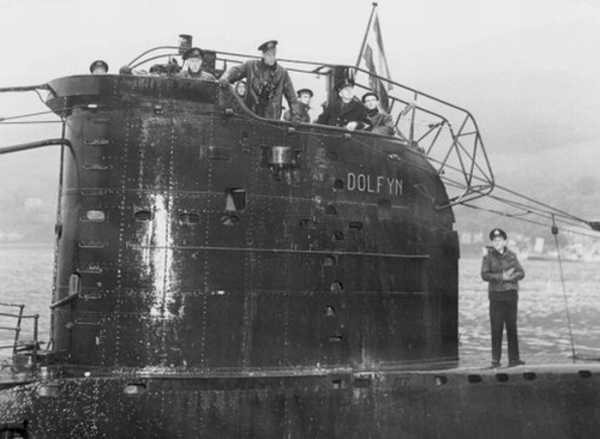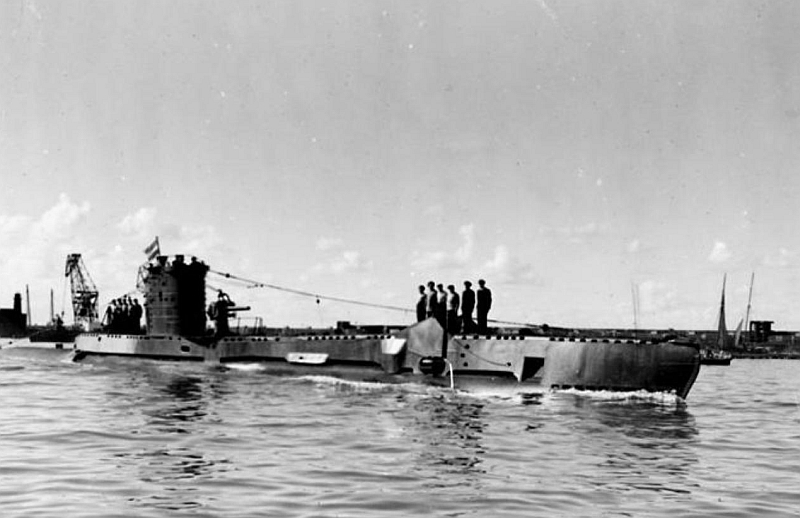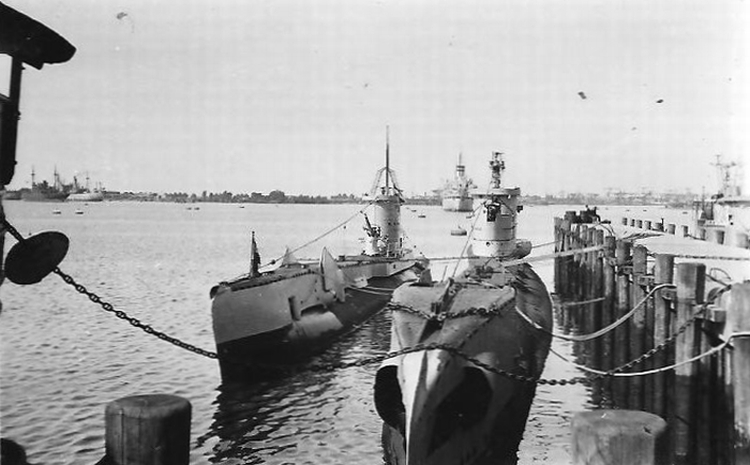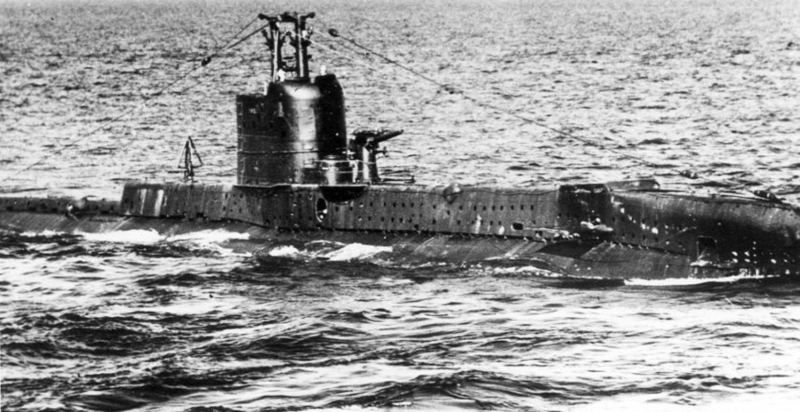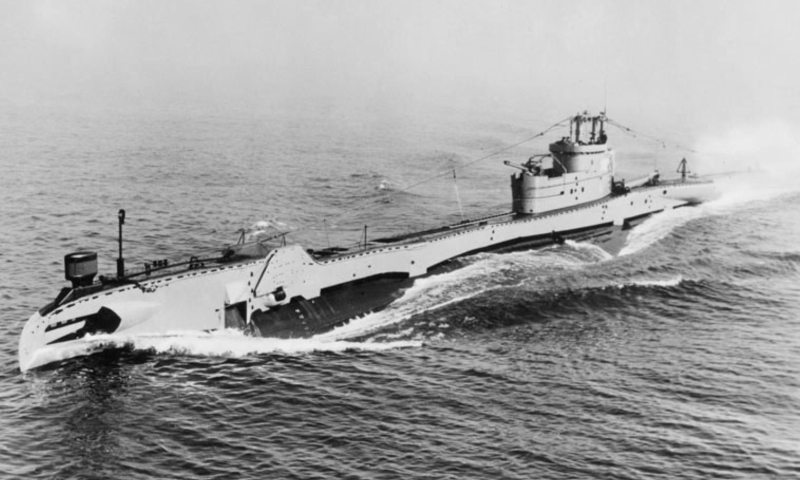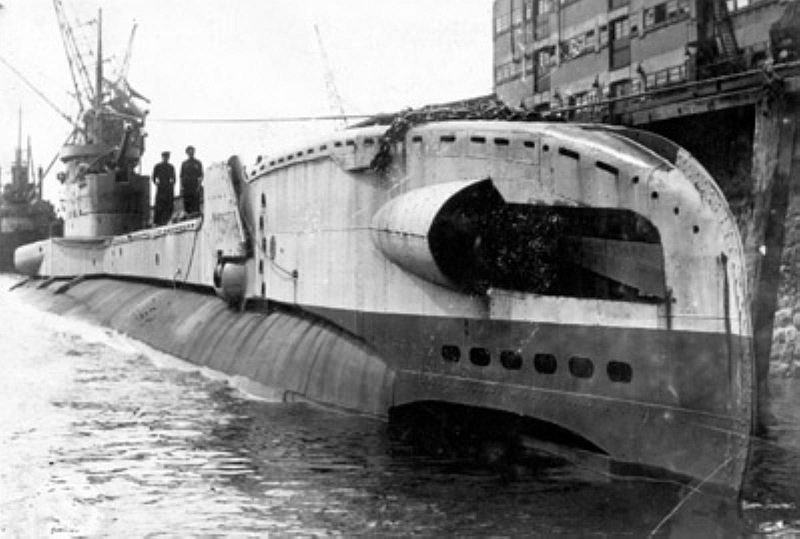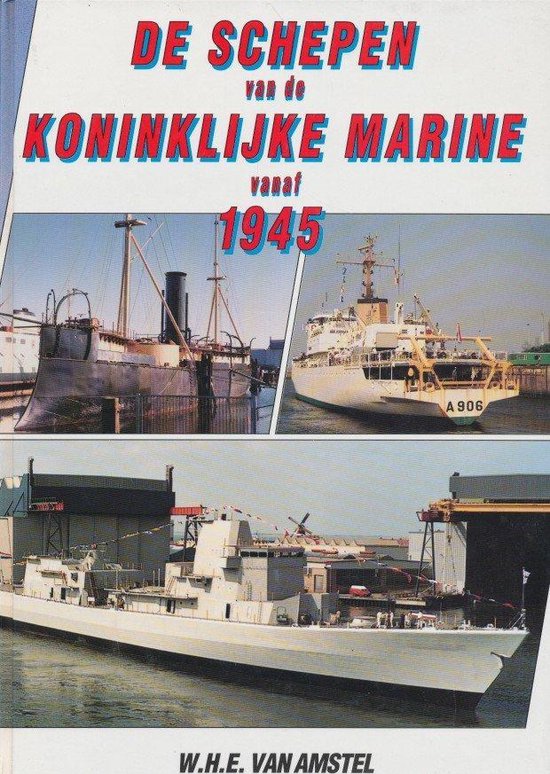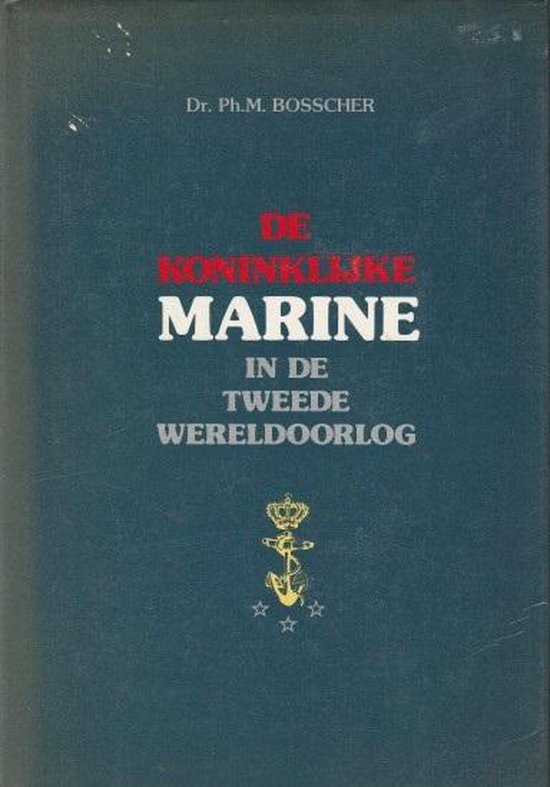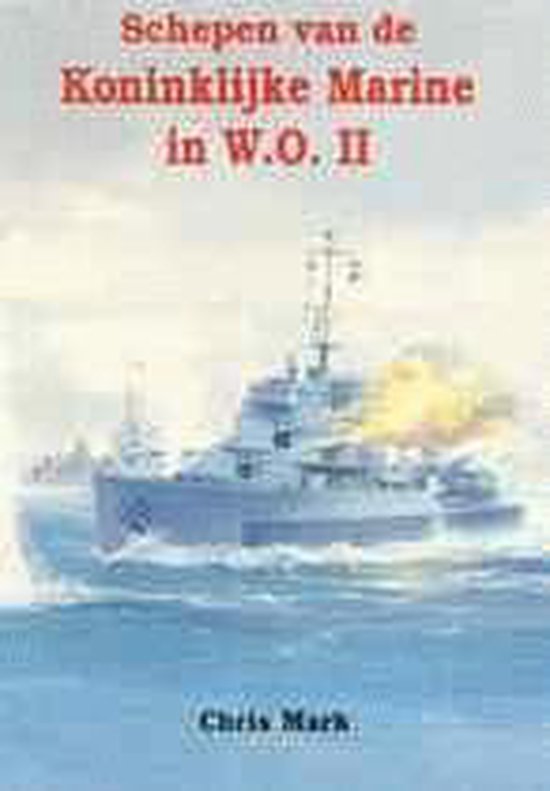Introduction
September 24th 1941, the Dutch navy contacted the British Admiralty with the request to take over three new British T-class submarines. The Royal Dutch Navy had lost Hr. Ms. O 8 and Hr. Ms. O 12, due to the fact that they fell into the hands of the Germans on the14th of May 1940. Furthermore the navy would like Hr. Ms. K VII and the three boats of the K VIII-class to be removed from the fleet and in order to provide the available crew the opportunity to perform their war tasks, new submarines were required. At that time, the Royal Navy could not do without the T-class submarines, but did offer two smaller, but modern, U-class submarines to the Dutch navy.
On October 8th 1942, the first of these U-class submarines, the former P 47 was transferred into the service of the Dutch navy, as Hr. Ms. Dolfyn, at Holy Loch, Scotland. The former P 66 was to follow soon and would be named Haai, however the order had to be cancelled because the majority of the crew, intended for this boat, had been killed. In Australia, in the summer of 1942, the crew was assembled from the remaining crew of Hr. Ms. K IX, Hr. Ms. K X and Hr. Ms. K XII, under the command of Lieutenant Commander HCJ Coumou. In August 1942, the crew left from Sydney to Britain with the steamer Westernland of the Holland America Line. In Cape Town, South Africa, the ship had to be disembarked because it was judged not to be fit for the task of the use as a troopship. Consequently the Dutch submarine crew had to change over to the modern British motor vessel Abosso of the Elder Dempster Line. However, this ship would not join a convoy to sail to Britain, but it sailed as so-called independer. In the evening of October 29th 1942, 20 days after leaving Cape Town, the Abosso got torpedoed by the German submarine U-575, in the middle of the Atlantic Ocean. From the 33 future crew members of the Haai, 28 lost their lives. Subsequently, in 1944, Great Britain transferred the P 66 to the Norwegian navy, who took the ship into service as Ula.
In June 1943, Hr. Ms. O 14 was put out of service due to serious technical defects. Thus a complete, trained submarine crew became available. The Royal Dutch Navy got HMS Sturgeon to their disposal, a British S-class submarine. In contrast to the Dolfyn, this boat was not purchased, but obtained in lend-lease and taken into Dutch service as Hr. Ms Zeehond on the 18th of October 1943. With this submarine, the crew continued the task of Hr. Ms. O 14 produced as an ASDIC training boat.
In 1943, the Dutch request to take over T-class submarines could partly be honoured. In that year, the Dutch navy could take over the Talent, which then was still under construction and which was taken into service on the 23rd of November, 1943, as Hr. Ms. Zwaardvisch. This T-class submarine, in Dutch service, was to carry out one of the most successful allied patrols during the Second World War. However, it would last until May 17th, 1944, before the British Admiralty announced that also the Tarn, which was still under construction, could be taken over. This T-class submarine was taken into service on the 28th of March 1945, as Hr. Ms. Tijgerhaai.
Images
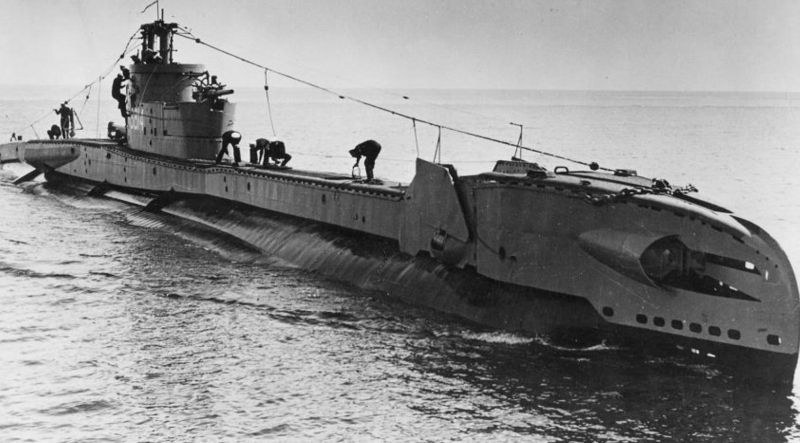 Hr. Ms. Zwaardvisch Source: Valka.
Hr. Ms. Zwaardvisch Source: Valka.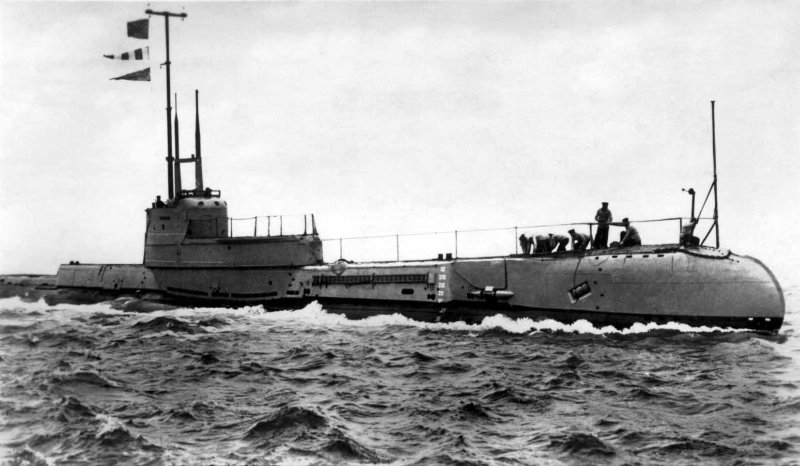 HMS Sturgeon (Hr. Ms. Zeehond) Source: Naval history.
HMS Sturgeon (Hr. Ms. Zeehond) Source: Naval history.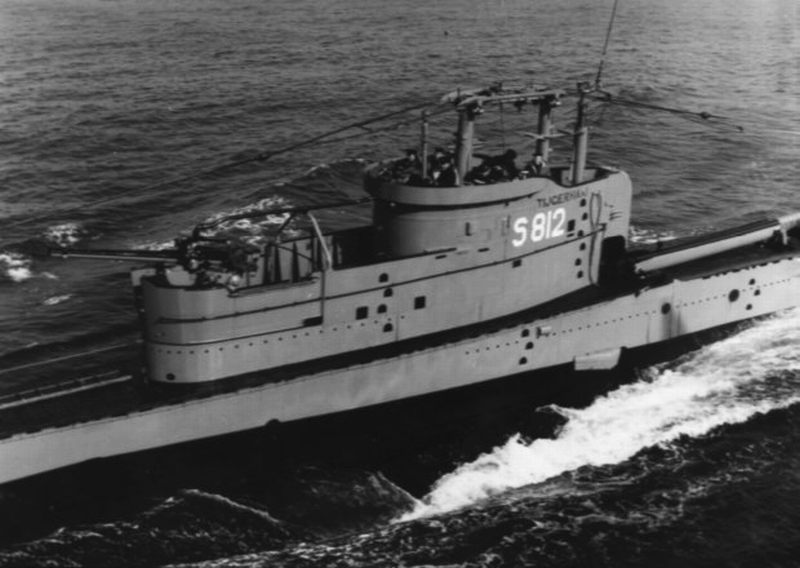 Hr. Ms. Tijgerhaai Source: Valka.
Hr. Ms. Tijgerhaai Source: Valka.Hr. Ms. Dolfyn
Technical data
| Class: | U-class 3rd group |
| British name: | P 47 |
| Boatyard: | Vickers-Armstrong in Barrow-in-Furness, Great Britain |
| Laid down: | November 19th 1941 |
| Launched: | July 27th 1942 |
| Taken into Dutch service: | October 8th 1942 |
| Overall length: | 60.05 meters |
| Beam: | 4.88 meters |
| Draught: | 3.87 meters |
| Standard displacement: | 545 tons |
| Displacement fully loaded above water: | 632 tons |
| Displacement fully loaded under water: | 735 tons |
| Machine installation: | 2 x 6-cylinder 4-stroke Davey Paxman-Ricardo diesels, 2 x 400 hp |
| Electric motors: | 2 x electric motors, 2 x 412 hp |
| Batteries: | 2 x 112 cells, 4,000 amps per hour for 5 hours |
| Propellers: | 2 |
| Bunker capacity: | 56 tons of diesel |
| Range above water: | 4,500 nautical miles at 10 knots |
| Range under water: | 30 nautical miles at 9 knots |
| Maximum speed above water: | 11.25 knots |
| Maximum speed under water: | 9 knots |
| Maximum depth: | 60 meters |
| Complement: | 27 to 31 |
| Torpedo tubes: | 4 x 53.3cm bow tubes |
| Torpedo's: | 8 x Mk VIII torpedoes |
| Other armaments: | 1 x 7.6cm deck gun |
Lieutenant H.M.L.F.E. Oostrom Soede was destined to become commander of Hr. Ms. Dolfyn. From the 15th of May 1942, he was closely involved in the construction of the submarine. From July 3rd to July 26th of that year he participated in a war patrol on board of the sister ship HMS P 48 to gain experience with a U-class submarine. On the 8th of October 1942, Hr. Ms. Dolfyn was taken into Dutch service by commander Van Oostrom Soede and this new submarine was put under British operational command at the 3rd Submarine Flotilla which had its base in Holy Loch, Scotland. Until November 14th 1942, the boat was worked up and the next day the Dutch submarine left to perform her first war patrol in the Bay of Biscay. During this patrol, on November 26th, a torpedo attack had been carried out on a German submarine, but the torpedo’s missed their target. The following two war patrols were also unsuccessful.
From January 23rd 1943, Hr. Ms. Dolfyn became part of the 8th Submarine Flotilla, based in Algiers, Algeria on the North African coast. During the first mission from Algiers, carried out by a Dutch submarine in the waters around Corsica and Sardinia, Hr. Ms. Dolfyn was to score her greatest success. On February 9th 1943, at the south west coast of Sardinia, the echo sound sensors of the Dolfyn detected the propeller noises of three ships. Only two Italian patrol boats could be observed through the periscope which made commander Van Oostrom Soede assume that the third ship had to be a submarine. At 10:48 pm the submarine surfaced unexpectedly and changed its course 9 minutes later, after which, on board the Dolfyn, she had been recognized as an Italian submarine from the Perla class. Less than two minutes later, Hr. Ms. Dolfyn fired four torpedoes at the enemy ship, with short intervals. The third torpedo hit the boat midships. The Italian submarine sank in less than a minute. The patrol boats were no threat to the Dolfyn, because they immediately started to pick up the survivors. Later on, the Italians acknowledged the loss of the 680 ton Perla class submarine Malachite and subsequently reported that the patrol boats had picked up 13 survivors including the commander of the Italian submarine, Tenente di vascello (Lieutenant Commander) A. Cinti. The remaining 32 Italian crew members were killed.
During the next war patrol, off Sardinia, Hr. Ms. Dolfyn unsuccessfully fired at another Italian submarine. The patrol from March 23rd to April 10th would be more successful. On the 29th of March 1943, off Sardinia again, the Dutch submarine sank the 1,143 ton Italian steamship Egle. During the next mission, on April 24th 1943, Hr. Ms. Dolfyn attacked a U-boat near Sicily, but the success of February 9th could not be repeated and the German submarine escaped the four Dutch torpedoes.
The sixth war patrol from Algiers, which would last from June 27th to July 20th 1943, was more successful. On the 4th of July, Hr. Ms. Dolfyn torpedoed the 5,788 ton Italian freighter Sabbia, which was heavily damaged. Italian tugs managed to take the merchant vessel to the nearby port Civitavecchia, near Rome, but due to an explosion the ship still became a total loss. The Dutch submarine managed to escape the depth bomb attack from a submarine hunter which had escorted the Sabbia. That same evening, at about 15 nautical miles northwest of Civitavecchia, the Dolfyn spotted the armed 165 ton schooner Adalia, which was used as a patrol boat. After the Dutch submarine had fired on the schooner with the 3 inch deck gun, it was abandoned by its crew. Commander Van Oostrom Soede sent a boarding team to the enemy ship, which captured all abandoned papers, before the schooner was sunk by means of an explosive charge. On July 13th an almost identical scenario happened, after Hr. Ms. Dolfyn had discovered the Italian, 137 tons, anti-aircraft schooner Stefano Galleno, again northwest of Civitavecchia.
On September 3rd 1943, a truce was signed in Algiers, by the Allies and Italy. An agreement provided that the Italian navy would move towards allied ports of war. On September 11th, Admiral Sir Andrew Browne Cunningham, commander of the British Mediterranean Fleet, reported: "be pleased to inform Their Lordships that the Italian battle fleet now lays at anchor under the guns of the fortress of Malta". That same day, Hr. Ms. Dolfyn patrolled near Bastia, on the north east coast of Corsica. Like all other allied warships Dolfyn had been instructed to consider Italian ships, carrying a black flag, to be an allied ship, as from September 9th. However, in the port of Bastia, two large Italian merchant ships were moored, which did not carry a black flag. Furthermore, the Dutch submarine discovered a German landing craft, which could sail in and out the Corsican port unimpeded. From this, Lieutenant Van Oostrom Soede concluded that the port and the ships had to be under German control. After the larger of the two Italian merchant ships, the 7,980 ton Humanitas, had left the port, Hr. Ms. Dolfyn thus immediately fired four torpedoes at the ship. One of the torpedoes was a direct hit to the stern of the Humanitas, which became heavily damaged. Due to the fact that the stricken vessel was accompanied by two enemy corvettes, Hr. Ms. Dolfyn was not in the position to finish the job.
The next day, September 12th 1943, the Dutch submarine returned to the same position. Unfortunately, there was nothing to be seen of the large Italian merchant ship anymore, except some oil and driftwood. Later that day the Dolfyn spotted the two Italian corvettes, which were under German flag, near Bastia, but not the Humanitas. On board the Dutch submarine it was assumed that the merchant ship had been sunk. After the war, Italian sources reported that the Humanitas had been sunk by two Italian corvettes, Gabbiano and Pellicano, on September 12th 1943, at about 22:00, after it had been severely damaged by an allied submarine.
On September 13th 1943, between Sestri Levante and La Spezia, in the Gulf of Genoa, Hr. Ms. Dolfyn did sink two German armed coasters with gunfire. This would be the last success of the Dutch submarine, for the time being. After a maintenance period on the British naval dockyard at Malta, Hr. Ms. Dolfyn was assigned to the 1st Submarine Flotilla and stationed in Beirut, Lebanon. From here patrols in the Aegean Sea were carried out. The attention was focused on the shipping traffic, which equipped the German occupational forces on the Greek islands with supplies. It was only towards the end of the last patrol in the Aegean Sea, that Hr. Ms. Dolfyn was able to sink two small, German deployed Greek coasters by gunfire, on April 17th 1944, near Milos.
On April 21st 1944, Hr. Ms. Dolfyn began its journey to return from Malta to Dundee in Scotland. On June 7th the Dutch submarine arrived at Dundee, where the boat was subjected to maintenance for four months. On August 21st 1944, during the maintenance period, Lieutenant Commander J.B.M.J.Weave took over the command of Hr. Ms. Dolfyn from commander Van Oostrom Soede. The last months of 1944 were used to work up the Dolfyn as well as using the boat as a training object in anti-submarine warfare exercises from Dundee.
On January 10th 1945, Hr. Ms. Dolfyn was put to sea for a war patrol in the North Sea. A few hours after departure, the boat was, unintended, attacked by the machine guns of four De Havilland Mosquito fighter-bombers of the Royal Air Force (RAF). This caused such damage to the Dutch submarine, especially to the bridge complex, that it had to return to Dundee for repair. During the last war patrols of Hr. Ms. Dolfyn in the North Sea, a U-boat reconnaissance was carried out twice, but in both situations, the Dutch submarine could not manoeuvre into a favourable launching position.
After the German surrender on May 8th 1945, Hr. Ms. Dolfyn was moored at the Parkkade in Rotterdam, from August 10th to September 5th, but was temporarily stationed in Dundee. At the end of 1946, the submarine finally returned to the Netherlands and was taken out of service in Rotterdam. From 1947 to 1952 the Dolfyn was used as training boat for technical personnel at the Technical Training School Royal Navy (TOKM) in Amsterdam. In May 1952 the submarine was sold to a scrap dealer in Krimpen aan den IJssel.
Definitielijst
- RAF
- Royal Air Force. British air force
- Torpedo
- A weapon of war. A cigar shaped body fitted with explosives and a propulsion and control mechanism. Intended to target after launch a nearby enemy ship and disable it by underwater explosion.
- U-boat
- The German name for a submarine. German U-Boats (Submarines) played a very important role during the course of warfare until May 1943. Many cargo and passenger ships were torpedoed and sunk by these assassins of the sea.
Images
Hr. Ms. Zeehond
Technical data
| Class: | S-class 1st group |
| British name: | HMS Sturgeon |
| Boatyard: | Royal Navy Dockyard in Chatham, Kent, Great Britain |
| Laid down: | January 3rd 1931 |
| Launched: | Januray 8th 1932 |
| Taken into Dutch service: | October 11th 1943 |
| Overall length: | 61.6 meters |
| Beam: | 7.1 meters |
| Draught: | 4.1 meters |
| Standard displacement: | 620 tons |
| Displacement fully loaded above water: | 730 tons |
| Displacement fully loaded under water: | 927 tons |
| Machine-installatie: | 2 x 6-cylinder 4-stroke Vickers diesels, 2 x 775 hp |
| Electric motors: | 2 x electric motors, 2 x 650 hp |
| Batteries: | 2 x 112 cells, 3,700 amps per hour for 5 hours |
| Propellers: | 2 |
| Bunker capacity: | 44 tons of diesel |
| Range above water: | 6,000 nautical miles at 10 knots |
| Range under water: | 30 nautical miles at 10 knots |
| Maximum speed above water: | 14 knots |
| Maximum speed under water: | 9 knots |
| Maximum depth: | 90 meters |
| Complement: | 40 |
| Torpedo tubes: | 4 x 53.3cm internal bow tubes, 2 x 53.3cm external bow tubes |
| Torpedo's: | 12 x Mk VIII torpedoes |
| Other armaments: | 1 x 7.6cm deck gun, 1 x 20mm machine gun |
On June 26th 1943, Hr. Ms. O 14 was taken out of service, due to serious technical defects and imposed in Dundee, Scotland. Especially the port diesel engine showed serious deficiencies and had to be written off. All usable parts were removed from the scrapped submarine and later on partly used for sister ship Hr. Ms. O 15. Another submarine was looked for, for the vacant crew. Again the British Admiralty was approached for this, which put submarine Sturgeon, which was temporarily out of service for maintenance, available on loan, provided that this ship would continue the tasks of Hr. Ms. O 14.
From November 1939 to August 1942, HMS Sturgeon had already sunk five enemy ships, including a German troop transport ship. On March 28th 1942, HMS Sturgeon served as a navigational beacon for HMS Campbeltown and the flotilla motor torpedo boats, during Operation Chariot, the raid on Saint-Nazaire. In April 1943, the British submarine was put out of service and went for major maintenance to Devonport in England.
During this maintenance period, Lieutenant Commander D.Th. Baron Mackay, put the submarine into Dutch service on October 11th 1943, as Hr. Ms. Zeehond. The Zeehond was intended to serve as a training boat for submarine warfare in Canada, but while crossing the Atlantic Ocean, the Dutch submarine ended up in heavy weather, which led to a too high fuel consumption. Consequently the boat had to turn back and arrived on November 13th 1943, in Rothesay, on the Firth of Clyde in Glasgow, Scotland. Here the decision was taken that the boat was not to make the crossing to Canada anymore, but to transfer it to the 7th Submarine Flotilla, which was stationed in Rothesay. From here the boat was mostly used as a training boat for ASDIC and anti-submarine exercises. From February 17th to February 26th and from March 18th to March 23rd 1944, Hr. Ms. Zeehond carried out two war patrols in the North Sea, during which no opportunity to attack enemy ships presented itself. Subsequently the submarine was used as training ship again.
On November 25th 1944, Hr. Ms. Zeehond was assigned to the 9th Submarine Flotilla, which operated from Dundee on the southeast coast of Scotland. In this flotilla, the Dutch submarine was used as a training boat again. On January 18th, 1945, Lieutenant Commander S.H. de Boer, became the new commander of Hr. Ms. Zeehond. After the surrender of Germany on the 8th of May 1945, Hr. Ms. Zeehond visited Rotterdam and returned back to Dundee, early September. Here the submarine was decommissioned on September 14th 1945, and on November 17th of the same year, the Zeehond returned to the Royal Navy. The Royal Navy did not have a post-war task for the submarine, which was technically almost completely written off. In 1946 the canabalized submarine was sold for demolition to Granton, Scotland and subsequently dismantled there in the course of 1946 and 1947.
Definitielijst
- machine gun
- Machine gun, an automatic heavy quick firearm.
- raid
- Fast military raid in enemy territory
- Torpedo
- A weapon of war. A cigar shaped body fitted with explosives and a propulsion and control mechanism. Intended to target after launch a nearby enemy ship and disable it by underwater explosion.
Images
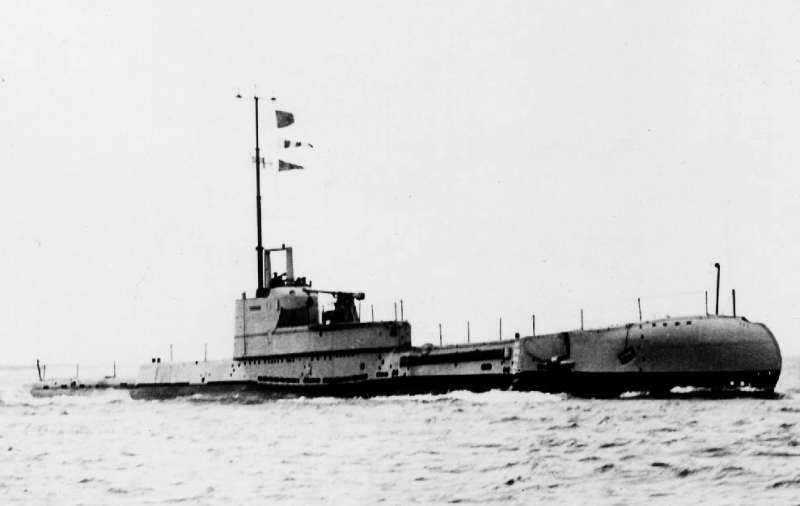 HMS Sturgeon (Hr. Ms. Zeehond) Source: Courtesy of David Page.
HMS Sturgeon (Hr. Ms. Zeehond) Source: Courtesy of David Page.Hr. Ms. Zwaardvisch
Technical data
| Class: | T-class 3rd group |
| British name: | HMS Talent |
| Boatyard: | Vickers-Armstrong in Barrow-in-Furness, Great Britain |
| Building number: | 805 |
| Laid down: | October 13th 1942 |
| Launched: | July 17th 1943 |
| Taken into Dutch service: | November 23rd 1943 |
| Overall length: | 83.34 meters |
| Beam: | 8.06 meters |
| Draught: | 4.5 meters |
| Standard displacement: | 1,090 tons |
| Displacement fully loaded above water: | 1,400 tons |
| Displacement fully loaded under water: | 1,557 tons |
| Machine-installatie: | 2 x 6-cylinder 4-stroke Vickers diesels, 2 x 1,250 hp |
| Electric motors: | 2 x Laurens Scott electric motors, 2 x 900 hp |
| Batteries: | 2 x 112 cells, 5,350 amps per hour for 5 hours |
| Propellers: | 2 |
| Bunker capacity: | 210 tons of diesel |
| Range above water: | 10,000 nautical miles at 10 knots |
| Range under water: | 30 nautical miles at 9 knots |
| Maximum speed above water: | 15.5 knots |
| Maximum speed under water: | 8.5 knots |
| Maximum depth: | 100 meters |
| Complement: | 61 |
| Torpedo tubes: | 6 x 53.3cm internal bow tubes, 2 x 53.3cm external bow tubes, 2 x 53.3cm midships tubes, 1 x 53.3cm stern tube |
| Torpedo's: | 17 to 19 x Mk VIII or Mk20 torpedoes |
| Other armaments: | 1 x 10.2cm Mk XII deck gun, 2 x 20mm machine guns |
On March 23rd 1943, the Royal Dutch Navy had the opportunity to take over the submarine Talent, which was just laid down, at Vickers-Armstrong in Barrow in Furness. This would be the first British T-class submarine, taken into Dutch service. Barely four months later, the Talent was launched and again four months later, on November 23rd 1943, taken into Dutch service by Lieutenant Commander HAW Goossens, as Hr. Ms. Zwaardvisch. The subsequent three months were used to work up from Holy Loch, Scotland. Until mid-May 1944, Hr. Ms. Zwaardvisch patrolled in the North Atlantic and along the Norwegian coast, but never had the opportunity to attack enemy ships during the patrols.
From May 16th to May 29th 1944, the Zwaardvisch patrolled along the Portuguese coast without spotting any enemy ships. On May 29th, the Dutch submarine moored in Gibraltar, where commander Goossens got orders to sail to Trincomalee in Ceylon. On July 12th 1944, Hr. Ms. Zwaardvisch arrived at the allied base in the Far East and came under British operational command as part of the British Eastern Fleet. From August 6th to September 7th Hr. Ms. Zwaardvisch carried out her first patrol from Ceylon, which would take the boat to the Strait of Malacca, between Sumatra and British Malaysia. There were many Chinese, armed junks (sailing with a mast and an auxiliary engine), which were claimed by the Japanese and subsequently were used as patrol vessels. On August 18th, Hr. Ms. Zwaardvisch sank the 48 ton junk Kim Hup Soon by gunfire near the island of Berhala, on the east coast of Sumatra. The next day, in the same area, again two junks of about 50 tons became the victims of the Dutch submarine. Before the Zwaardvisch headed for Christmas Island, where it was to carry out a reconnaissance mission, it sank a fourth, 32 ton, junk on August 21st. On September 7th Hr. Ms. Zwaardvisch arrived in Fremantle, Western Australia, where it was put under American operational command, just like Hr. Ms. O 19 and Hr. Ms. O 24.
From September 26th to October 26th 1944, Hr. Ms. Zwaardvisch carried out a very successful war patrol in the waters around Java and Bali. In the early morning of October 4th, the Dutch submarine met a small Japanese tanker of about 500 tons, which was sunk by the deck gun, off the coast of Bali. Two days later, Hr. Ms. Zwaardvisch was heading west on the north coast of Java at the height of Gunung Lasem, when it reconnoitred a submarine, which sailed, on the surface, to the east at a speed of 14 knots. The former senior officer of Hr. Ms. Zwaardvisch, Lieutenant J. van Dapperen, made an extensive report of the successful patrol. He wrote: "We are ready. Only that damned nationality. We are close now and are not allowed to look through the periscope for more than a few seconds. "Up," said the commander, "down". A look at the silhouette in the book. The old man was covered with beads of sweat. He has to take a terrible decision. Then he says: "Damn, a swastika, put him on the bearing, be careful, is it 17 1/2 degrees Fire!". Six torpedoes are fired. At each torpedo the ship bounces back and the air pressure increases. 800 meters was the distance, which will take 40 seconds for the torpedoes. It seems like an eternity, compared to the 11 minutes which passed since the spotting of the U-boat. The periscope remains down. Squatted behind it sits the commander, his eyes casted down. We are now invisible. He looked eight times in total, every time just a few seconds. That was sufficient to cover the past and to sign a death sentence. In 11 minutes, everything was found out about her, of something that would not be there anymore in the twelfth minute: a doomed submarine, the type and tonnage, length and depth, course and speed and even the type of people on board. 60 Man in the craziest outfit have worked at it, 6 torpedoes will do the rest. It is death quiet in the ship. The 4 torpedo makers in the bow tube room are listening. "40 Seconds" counted Quartermaster Claus, "41 ... 42 ...". Then there was a dull explosion, not even a hard one. " Periscope up" said the commander. I saw him blush. "Look," he whispered, "quickly". That was the last look out there at the U-boat. 17 seconds after the explosion, with a major incline forward, the last tip of her tail disappeared underwater, for ever ".
The German submarine sank at about 20 miles north of Rembang. Out of the six torpedoes fired, three hit the target, but only one exploded. Commander Goossens, who was aware of the mechanical problems of his torpedoes, had decided to fire six torpedoes at the U-boat instead of the usual four, for such a target at a distance of 800 meters, which proved to be a correct decision. Ten minutes after the U-boat had sunk, Hr. Ms. Zwaardvisch headed to the area involved and surfaced. There were 27 survivors, most of whom were transferred to a fishing boat that was in the vicinity. Five men, including the commander, Kapitänleutnant H. Pich, were detained on board the Dutch submarine. Their interrogation revealed that the Zwaardvisch had sunk U-168, a type IX C40 ocean liner of 1,247 ton under water and a range of 11,400 nautical miles. Throughout the Second World War only 14 U-boats have been sunk by allied submarines. Therefore, the sinking of U-168 by Hr. Ms. Zwaardvisch may be regarded as a particularly great success. Hr. Ms. O 21 was the only other Dutch submarine which delivered a similar performance, when it sank the German U-95 with just one single torpedo hit, on November 28th 1941, in the Mediterranean.
The successes during this war patrol of Hr. Ms. Zwaardvisch still continued. On October 10th 1944, an armed 500 ton Japanese coaster was sunk by gunfire, between Surabaya and Bawean island in the Java Sea. Five days later, the 143 ton Japanese coaster Kaiyo Maru experienced the same fate. In the morning of October 17th, between the islands Bawean and Masalembo, Hr. Ms. Zwaardvisch spotted a Japanese fleet formation, consisting of two minelayers, Itsukushima and Wakataka, accompanied by three destroyers. During the approach manoeuvre of the Dutch submarine, the Wakataka headed straight towards the Zwaardvisch at a distance of about 800 meters. Commander Goossens fired two torpedoes at this nearest target and three at the other minelayer. Hereafter three explosions were heard, one very loud and two lighter ones. Then, Hr. Ms. Zwaardvisch was chased for hours by three enemy torpedo boats, which attacked the Dutch submarine with depth charges. Around noon, the Zwaardvisch could go to periscope depth and at the distance of a mile, the torpedo boats could be spotted. Nothing had been heard of the minelayers anymore. After the war, Japanese sources stated that the 2,330 ton Itsukushima sank and the 1,970 ton Wakataka was heavily damaged. The number of torpedoes has decreased to three and since Hr. Ms. Zwaardvisch had received the order to cancel the patrol when the number of torpedoes in stock had reached three, that afternoon, the boat sailed to the Strait of Lombok, between Bali and Lombok. When these narrows were crossed, on October 19th a week later, on October 26th 1944, the Zwaardvisch safely arrived in the port of Fremantle.
The next patrols of Hr. Ms. Zwaardvisch would elapse considerably less successful. After the Dutch submarine had left Fremantle on November 28th 1944, it was attacked by Japanese patrol vessels and bombarded with depth charges, on December 6th, at the southern entrance of Strait of Lombok. Within a minute at least ten explosions were noticed. Lieutenant Van Dapperen wrote: "There was water that gushed inside through the shutters at every blow, there was a fire in the main electric motors, air cylinders were sizzling. There was the echo sounder, 10 meters below the maximum depth ... 20 ... 30 ". Such a second volley would probably have been fatal to the Dutch submarine, but it would not come that far.
Because of the damages incurred, the patrol had to be abandoned and on December 20th, the beaten ship put into the port of Fremantle. The repairs would take over a month. During the next patrol, on February 16th 1945, Hr. Ms. Zwaardvisch, was attacked by Japanese aircraft and shelled with four bombs, while it was sailing on the surface. The bombs exploded near the submarine, which had not had the opportunity to submerge. The Zwaardvisch, severely damaged, had to return to Fremantle, escorted by the American submarine USS Charr.
During the repair period, commander Goossens was relieved by his eldest officer Lieutenant J. van Dapperen, on March 23rd 1945, due to health reasons. From April 9th to May 9th 1945, Hr. Ms. Zwaardvisch carried out her last war patrol, which would take her to the Java Sea again. The only small success the submarine was able to record, occurred on April 25th, when the enemy light trading vessels, the 40 ton Nomura and the 30 ton Albania, loaded with coal, were sunk by means of using on-board explosives. On June 14th 1945, the Zwaardvisch returned to Britain for maintenance.
After the Second World War, Hr. Ms. Zwaardvisch, which was named Hr. Ms. Zwaardvis from 1950, according to the new Dutch spelling rules, was in service for a long time still. She mainly practiced, alternately, with the squadrons 1 and 5. From March 4th 1961, the submarine was only used as torpedo ranging vessel and finally on December 11th 1962, she was taken out of service. On July 12th 1963, the Zwaardvis was sold to Jos Desmedt in Antwerp for scrapping.
Definitielijst
- mid
- Military intelligence service.
- swastika
- Equilateral cross, symbol of Nazi-Germany.
- Torpedo
- A weapon of war. A cigar shaped body fitted with explosives and a propulsion and control mechanism. Intended to target after launch a nearby enemy ship and disable it by underwater explosion.
- U-boat
- The German name for a submarine. German U-Boats (Submarines) played a very important role during the course of warfare until May 1943. Many cargo and passenger ships were torpedoed and sunk by these assassins of the sea.
Images
 Hr. Ms. Zwaardvisch moors alongside Hr. Ms. O 23 Source: Valka.
Hr. Ms. Zwaardvisch moors alongside Hr. Ms. O 23 Source: Valka.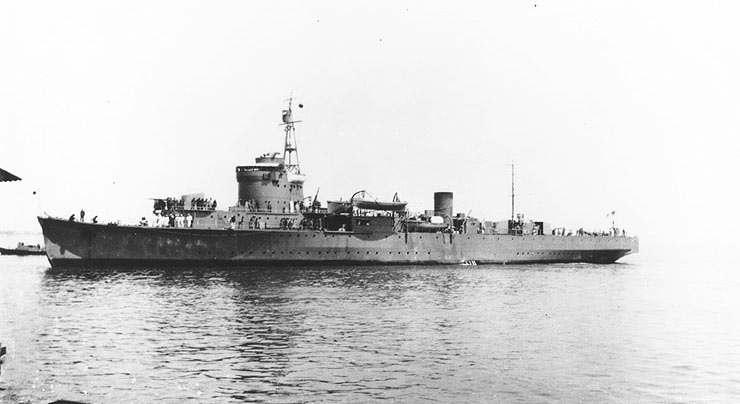 The Japanese minelayer Itsukushima was one of the victims of Hr. Ms. Zwaardvisch Source: World War 2 data base.
The Japanese minelayer Itsukushima was one of the victims of Hr. Ms. Zwaardvisch Source: World War 2 data base.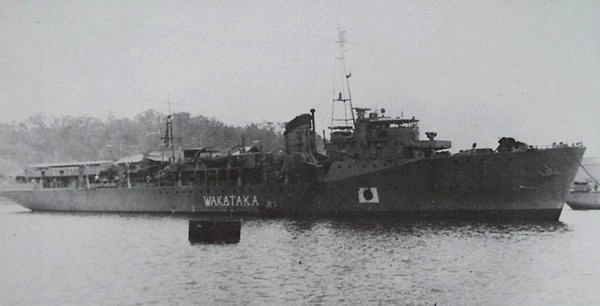 The Japanese minelayer Wakataka in 1947 Source: Wikipedia.
The Japanese minelayer Wakataka in 1947 Source: Wikipedia.Hr. Ms. Tijgerhaai
Technical data
| Class: | T-class 3rd group |
| British name: | HMS Tarn |
| Building number: | 843 |
| Laid down: | June 12th 1943 |
| Launched: | November 29th 1944 |
| Taken into Dutch service: | March 28th 1945 |
All other technical data is the same as Hr. Ms. Zwaardvisch.
On May 17th 1944, the British Admiralty offered the Royal Dutch Navy the possibility to take over the T-class submarine Tarn, which, at that moment, was under construction at Vickers Armstrong in Barrow in Furness. On March 28th 1945, Lieutenant Commander A. Altena became the first commander of the new submarine that was put into Dutch service that day as Hr. Ms. Tijgerhaai. Altena and his crew worked up from Holy Loch, Scotland, which took until the end of April.
When Germany surrendered on May 8th 1945, Hr. Ms. Tijgerhaai had not carried out any war patrol. After a visit to Rotterdam, the Tijgerhaai was prepared, from July 3rd, in Holy Loch to perform her duties in the Far East. On August 5th, the new submarine left for Australia to join the other Dutch submarines, which were stationed in Fremantle. Because of the fact that Japan surrendered on August 15th 1945, Hr. Ms. Tijgerhaai arrived too late for battle.
From September 1945 Hr. Ms. Tijgerhaai was stationed in Tandjong Priok, the port of Batavia, Java. Before the submarine was the last Dutch submarine, to arrive in Rotterdam on July 26th 1946, she performed several patrols in Indonesian waters. These patrols were primarily intended to prevent smuggling of weapons and arms by Indonesian freedom fighters. In subsequent years, the submarine exercised regularly with the squadrons 1 and 5 and she was used for showing the flag. On December 11th 1964, the Tijgerhaai was taken out of service and put into reserve. The submarine was no longer to be used in active service and was sold to Amsterdam for scrapping, on November 5th 1965.
Images
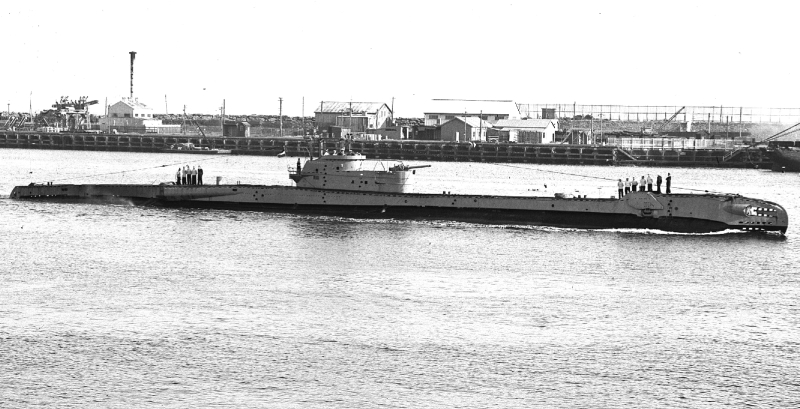 Hr. Ms. Tijgerhaai in Fremantle, 1945 Source: Dutchfleet.
Hr. Ms. Tijgerhaai in Fremantle, 1945 Source: Dutchfleet.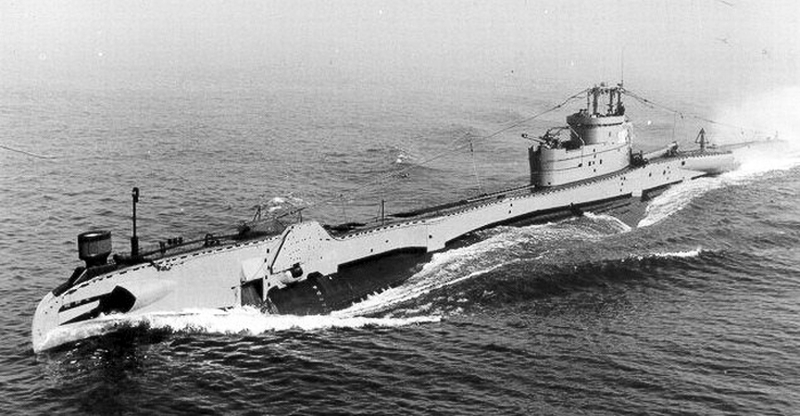 Hr. Ms. Tijgerhaai after the Second World War Source: Valka.
Hr. Ms. Tijgerhaai after the Second World War Source: Valka.Conclusion
In June 1948 the Royal Dutch Navy was provided with two more British T-class submarines. These were ex-HMS Taurus and ex-HMS Tapir, which were put into Dutch service as Hr. Ms. Dolfijn (2) and Hr. Ms. Zeehond (2). From 1948 to 1953, the four T-class submarines formed the backbone of the Dutch submarine service. In 1953, the lend-lease contract with the Royal Navy expired and the Dolfijn (2) and the Zeehond (2) had to be returned to the British navy. In that year, in order to replace the two British submarines, the Royal Dutch Navy received two converted American Balao-class submarines under the Mutual Defence Aid Program (MDAP). This aid program was created by the United States, after the war, to support the European countries to build up their forces. The aim of the MDAP was to ensure that Western Europe was kept out of control by the Soviet Union. The ex-USS Ice fish and ex-USS Hawksbill were put into Dutch service in 1953 as Hr. Ms. Walrus and Hr. Ms. Zeeleeuw. The Walrus and Zeeleeuw were the last Dutch submarines of foreign make. The future submarines in Dutch service were all designed and built in the Netherlands.
The successful Dutch development of the design and construction of submarines was called to a halt on May 10th 1940 by the German invasion. Because of the fact that most Dutch submarines were lost during the Second World War or were out of service due to old age, the Dutch submarine service needed eight foreign submarines to fill the 20-year gap up to the construction of the first post-war boats. The first Dutch submarines, built in the Netherlands again, were the two Dolfijn-class submarines, which were put into Dutch service in 1960 as Hr. Ms. Dolfijn (3) and in 1961 as Hr. Ms. Zeehond (3).
Definitielijst
- invasion
- Armed incursion.
- Soviet Union
- Soviet Russia, alternative name for the USSR.
Images
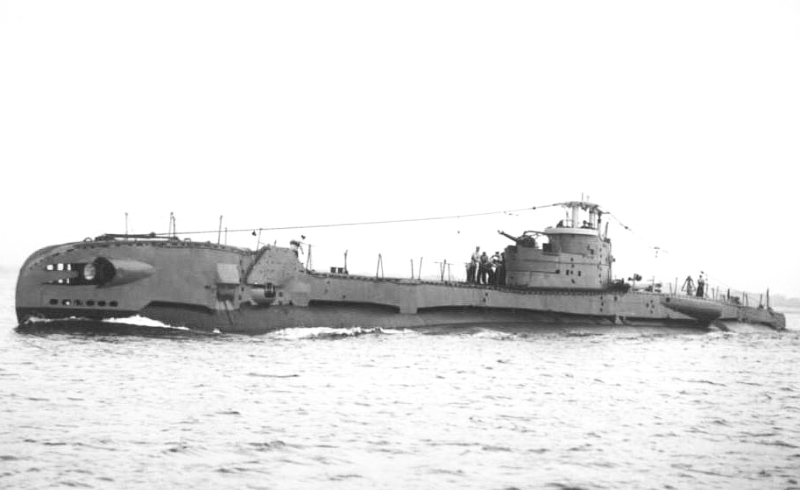 HMS Tapir, future Hr. Ms. Zeehond (2) Source: Naval history.
HMS Tapir, future Hr. Ms. Zeehond (2) Source: Naval history.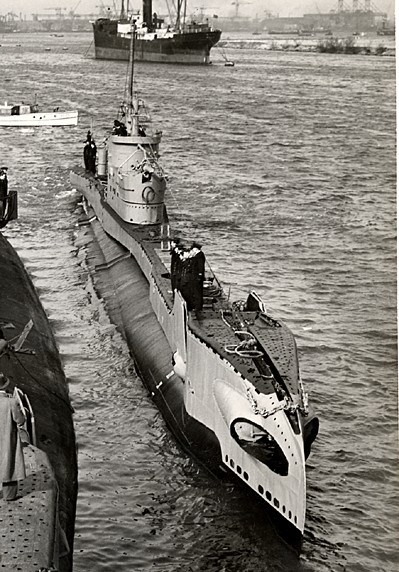 Hr. Ms. Dolfijn (2,) ex HMS Taurus Source: Wikipedia.
Hr. Ms. Dolfijn (2,) ex HMS Taurus Source: Wikipedia. Hr. Ms. Walrus, ex USS Icefish Source: Wikipedia.
Hr. Ms. Walrus, ex USS Icefish Source: Wikipedia.Information
- Article by:
- Peter Kimenai
- Translated by:
- Chrit Houben
- Published on:
- 09-11-2012
- Last edit on:
- 23-07-2023
- Feedback?
- Send it!
Related sights
Related books
Sources
- AMSTEL W.H.E. VAN, De schepen van de Koninklijke Marine vanaf 1945, De Alk bv, Alkmaar, 1991.
- BEZEMER, K.W.L., Verdreven doch niet verslagen, Uitgeversmaatschappij W. de Haan N.V., Hilversum, 1967.
- BOSSCHER, PH., M., De Koninklijke Marine in de Tweede Wereldoorlog deel 2, Uitgeverij T. Wever B.V., Franeker, 1986.
- BOSSCHER, PH., M., De Koninklijke Marine in de Tweede Wereldoorlog deel 3, Uitgeverij T. Wever B.V., Franeker, 1990.
- MARK, C., Schepen van de Koninklijke Marine in W.O. II, De Alk bv, Alkmaar, 1997.
- MüNCHING, L.L. VON, Schepen van de Koninklijke Marine in de 2e wereldoorlog, De Alk bv, Alkmaar, 1978.
- POOLMAN, K., Allied Submarines of World War Two, Arms & Armour Press, London, 1990.
